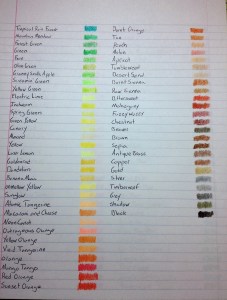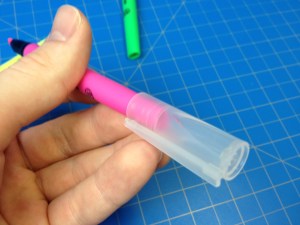And now it’s time for part 3 of this series (that is taking longer than expected) looking at all of the colors that come in the Crayola crayons 120 box set. This time it’s greens, yellows, and a few oranges; let’s take a look.
Jungle Green – Starting off, “jungle green” is what I can only describe as a “wet” green color. It’s not really blue-ish, but it just seems damp. The coverage is good, as most of the greens will turn out to be, but I’m just not sure how useful it would be for anything other than those weird sea-green shorts.
Pine Green – A theme with this first section of greens is going to be my wonder at why they were named that, and this continues the trend. While it is the color of some evergreens, I wouldn’t say this slightly-blue dark green represents pines. It covers kinda splotchy, but does make a good forest tree color, especially in the winter.
Jungle Green (Shamrock) – Now here’s going to be a little problem in this review; there is supposed to be another color called “shamrock” here, but instead I received a second “jungle green”. I do understand that this sort of thing is bound to happen, but I am a little disappointed and I hope it isn’t a common occurrence.
Asparagus – An unpleasant, yucky looking green that does indeed resemble some shades of asparagus (though not any I would be eating). It covers well enough and has much more shading ability than the majority of other colors in the set. Unfortunately its uses are quite limited and not on the nice side: like swamp yuck or vomit.
Tropical Rain Forest – Looking a little too blue for its namesake, Tropical Rain Forest is a deep aqua color. It covers fine and is a nice shading… well… shade. In tandem with other colors it works very well but little vegetation or really anything is around that will use it as a primary color.
Mountain Meadow – An oddly specific name for a rather plain looking green. Mountain Meadow is a slightly lighter and bluer color than regular “green”. It covers well in the normal range and has pretty standard green applications, though there aren’t any specific applications I can think of. It is a pleasant looking addition that adds some nice variation in shades (tints).
Forest Green – A color name that, along with “hunter green”, always confused me. This vaguely evergreen or dying-plant color covers poorly for a green and shades a little more than usual. While it isn’t a color that would be unused in the forest, it isn’t a usual main one and would be most at home coloring evergreens or parts of hunter’s vests.
Green – One of the standard 8 Crayola colors, Green is a very recognizable color with good properties. It’s nicely situated near the middle of the green spectrum and is suitable for all one’s foliage needs as well as for almost anything “green” made by humans. It covers quite well but has more pronounced darker spots than other colors in the area.
Fern – Vaguely fern-like, this pale green does a decent job of covering and highlights or lighter spots on plants. If I had been consulted I would’ve called it more of a “mint” myself, or “green army from Risk”.
Olive Green – Quite olive-colored (the green kind at least), and not really similar to military uniforms, I feel like Olive Green has a bit of a singular purpose. It isn’t the best at coverage and other than green-olives and pickles it looks a bit yucky.
Granny Smith Apple – Slightly darker in my experience than its namesake, Granny Smith Apple does resemble the famous apple skin and is a nice color to use in other plants or un-ripe fruits. It doesn’t provide the greatest coverage (being rather stipple-y) and will likely need a “support” color.
Screamin’ Green – And interesting name for a poor color, this neon lime green is an eyesore and not too great at coverage. Its uses would be limited to coloring neon signs, what one would write on black paper to make it “radical”, and perhaps radioactive waste. But I guess that’s more from a realistic perspective. Kids do like their neon.
Yellow Green – Much more green than yellow, Yellow Green is a light vomit-esque green color that covers decently but isn’t that pleasant to look at, though in the right light it could be the color of unripe fruit or changing leaves.
Electric Lime – The other neon green, Electric Lime is almost invisible on the paper and has very poor coverage. This is one where darker paper would be necessary and also the only use I could find for such a color.
Inchworm – Similar to Inchworms from children’s books, but not those from real life, this color covers well but has a bit of shading to go along with it. It could be used as a green highlight, for changing fruit or leaf colors, or, less pleasantly, for swamp muck in summer.
Spring Green – Another nearly invisible color that is much easier on the eyes. It is a vaguely green yellow that I could also call “autumn green” as it looks like grasses as they yellow in the fall or come back in the early spring. When colored in, it covers fine enough but has the consistency of grass and the green and yellow separate a bit.
Green yellow – An aptly named green-tinged yellow; Green Yellow is quite light and hard to see. It covers fairly well but with subtle shading that is hard to see at first. It is a good green highlight color, a likeness for grass turning yellow in the fall, and the color of some pears or apples.
Canary – A very muted yellow that is probably the hardest color to see in this section. I wouldn’t say it’s very good at imitating its namesake, but it does cover decently. I would still have a hard time trying to find a place to use it.
Almond – Not a dead ringer for either of the colors I associate with the nut, this Almond color much more resembles the off-white inside than the brown outside. In the end, though, I’d probably call it a very white yellow, perhaps an “eggshell”. The consistency (and thus the coverage) is very smooth and the uses are very interesting: cream, or eggshells, or sun-bleached something (paper?), but it’s subtle enough that it likely won’t be used to its full potential.
Yellow – Another one of the classics, plain yellow is a surprisingly deep and saturated yellow. The coverage is very good, and the shade is only slightly unnatural. It works well for many flowers (dandelions, sunflowers, etc.) and summer clothes, though on its own it is a little overpowering, and it needs to be augmented with other yellows.
Laser Lemon – High in my category of less-than-favorite is Laser Lemon, a particularly hard-to-see shade of slightly-neon yellow. It’s nearly transparent and the coverage is hard to discern but I’d say it’s patchy. It would make an interesting highlight or sign color, but that’s being generous.
Goldenrod – Goldenrod is a vaguely gold color that is more like a darker version of the following Dandelion. It’s the darkest/deepest of the yellows and as such is a tad on the messy side and its inconsistency doesn’t help. It’s a useful color for shading, darker flowers, and perhaps older plastics, but I don’t see it coming out often.
Dandelion – A bit darker than the flower it’s named after, Dandelion is a nice strong yellow that isn’t particularly pleasant, but also isn’t very yucky. It’s got great coverage but the layer has some inconsistencies and darker patches. It still looks fairly natural and is easier on the eyes than many yellows, making it good for large patches of the color, bees, flowers, and many human-made items like raincoats.
Banana Mania – This one sounds like a disease from a comic book, and is a much more orange/peachy color than one would expect from a “banana”. In fact it would work well for small fruits like apricots and peaches in their various forms as well as skin tones, though not as well, since, while it does cover well, it covers unevenly.
Unmellow Yellow – Like Laser Lemon but a bit more yellow and less neon, Unmellow Yellow has a terrible name that doesn’t really evoke a color in my mind. This one is hard to see, and hard to find uses for, looking both unnatural and unlike many man-made objects. The best I can come up with is yellow on TV/computer screens and the like. It does almost look like it’s glowing with its decent but incomplete coverage.
Sunglow – The name here is a semi-accurate description for this morning-ish orange color. It’s very light, almost fluorescent, and covers quite poorly, but it is a good rising/setting sun or hot coals kinda color.
Atomic Tangerine – These names aren’t getting any easier for me, but this one is apt. This color has minimal coverage and a “neon” quality, but it is actually dark enough to see on the paper and would be vaguely reminiscent of a tangerine that happened to get irradiated. Low sunset or safety vests is about all I can think of here.
Macaroni and Cheese – I’m gonna call this one flat wrong, and if you have macaroni and cheese that looks like this it might be tasting a bit funny. This slightly brownish orange covers quite well but I have a hard time placing it. Maybe those orangish brick buildings or left-out grapefruit peel.
Neon Carrot – Very similar to Atomic Tangerine and perhaps a little on the light side for its name, this color has passable coverage and is hard to see, being both very light and lacking that punch the other neon colors have. Its uses are very limited and it just seems to lack purpose.
Outrageous Orange – A real safety vest color, this one has quite poor coverage and high shading, making getting an even “coat” almost impossible. It is a neon-ish color and would do well as the tape used by surveyors or blended into a sunset, but it lacks a natural look.


And that’s another 30 colors down, and in my opinion they were a bit disappointing, and without many uses. Next time we’ll be finishing up the set with the final 30 from orange to earth-tones (much more useful) and taking a look at the included crayon sharpener.


















